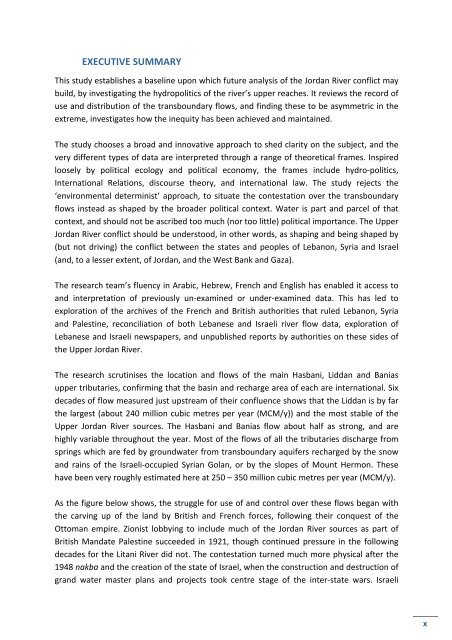Hydro-‐political Baseline of the Upper Jordan River - Ibrahim Abd El Al
Hydro-‐political Baseline of the Upper Jordan River - Ibrahim Abd El Al
Hydro-‐political Baseline of the Upper Jordan River - Ibrahim Abd El Al
You also want an ePaper? Increase the reach of your titles
YUMPU automatically turns print PDFs into web optimized ePapers that Google loves.
EXECUTIVE SUMMARY<br />
This study establishes a baseline upon which future analysis <strong>of</strong> <strong>the</strong> <strong>Jordan</strong> <strong>River</strong> conflict may<br />
build, by investigating <strong>the</strong> hydropolitics <strong>of</strong> <strong>the</strong> river’s upper reaches. It reviews <strong>the</strong> record <strong>of</strong><br />
use and distribution <strong>of</strong> <strong>the</strong> transboundary flows, and finding <strong>the</strong>se to be asymmetric in <strong>the</strong><br />
extreme, investigates how <strong>the</strong> inequity has been achieved and maintained.<br />
The study chooses a broad and innovative approach to shed clarity on <strong>the</strong> subject, and <strong>the</strong><br />
very different types <strong>of</strong> data are interpreted through a range <strong>of</strong> <strong>the</strong>oretical frames. Inspired<br />
loosely by political ecology and political economy, <strong>the</strong> frames include hydro-‐politics,<br />
International Relations, discourse <strong>the</strong>ory, and international law. The study rejects <strong>the</strong><br />
‘environmental determinist’ approach, to situate <strong>the</strong> contestation over <strong>the</strong> transboundary<br />
flows instead as shaped by <strong>the</strong> broader political context. Water is part and parcel <strong>of</strong> that<br />
context, and should not be ascribed too much (nor too little) political importance. The <strong>Upper</strong><br />
<strong>Jordan</strong> <strong>River</strong> conflict should be understood, in o<strong>the</strong>r words, as shaping and being shaped by<br />
(but not driving) <strong>the</strong> conflict between <strong>the</strong> states and peoples <strong>of</strong> Lebanon, Syria and Israel<br />
(and, to a lesser extent, <strong>of</strong> <strong>Jordan</strong>, and <strong>the</strong> West Bank and Gaza).<br />
The research team’s fluency in Arabic, Hebrew, French and English has enabled it access to<br />
and interpretation <strong>of</strong> previously un-‐examined or under-‐examined data. This has led to<br />
exploration <strong>of</strong> <strong>the</strong> archives <strong>of</strong> <strong>the</strong> French and British authorities that ruled Lebanon, Syria<br />
and Palestine, reconciliation <strong>of</strong> both Lebanese and Israeli river flow data, exploration <strong>of</strong><br />
Lebanese and Israeli newspapers, and unpublished reports by authorities on <strong>the</strong>se sides <strong>of</strong><br />
<strong>the</strong> <strong>Upper</strong> <strong>Jordan</strong> <strong>River</strong>.<br />
The research scrutinises <strong>the</strong> location and flows <strong>of</strong> <strong>the</strong> main Hasbani, Liddan and Banias<br />
upper tributaries, confirming that <strong>the</strong> basin and recharge area <strong>of</strong> each are international. Six<br />
decades <strong>of</strong> flow measured just upstream <strong>of</strong> <strong>the</strong>ir confluence shows that <strong>the</strong> Liddan is by far<br />
<strong>the</strong> largest (about 240 million cubic metres per year (MCM/y)) and <strong>the</strong> most stable <strong>of</strong> <strong>the</strong><br />
<strong>Upper</strong> <strong>Jordan</strong> <strong>River</strong> sources. The Hasbani and Banias flow about half as strong, and are<br />
highly variable throughout <strong>the</strong> year. Most <strong>of</strong> <strong>the</strong> flows <strong>of</strong> all <strong>the</strong> tributaries discharge from<br />
springs which are fed by groundwater from transboundary aquifers recharged by <strong>the</strong> snow<br />
and rains <strong>of</strong> <strong>the</strong> Israeli-‐occupied Syrian Golan, or by <strong>the</strong> slopes <strong>of</strong> Mount Hermon. These<br />
have been very roughly estimated here at 250 – 350 million cubic metres per year (MCM/y).<br />
As <strong>the</strong> figure below shows, <strong>the</strong> struggle for use <strong>of</strong> and control over <strong>the</strong>se flows began with<br />
<strong>the</strong> carving up <strong>of</strong> <strong>the</strong> land by British and French forces, following <strong>the</strong>ir conquest <strong>of</strong> <strong>the</strong><br />
Ottoman empire. Zionist lobbying to include much <strong>of</strong> <strong>the</strong> <strong>Jordan</strong> <strong>River</strong> sources as part <strong>of</strong><br />
British Mandate Palestine succeeded in 1921, though continued pressure in <strong>the</strong> following<br />
decades for <strong>the</strong> Litani <strong>River</strong> did not. The contestation turned much more physical after <strong>the</strong><br />
1948 nakba and <strong>the</strong> creation <strong>of</strong> <strong>the</strong> state <strong>of</strong> Israel, when <strong>the</strong> construction and destruction <strong>of</strong><br />
grand water master plans and projects took centre stage <strong>of</strong> <strong>the</strong> inter-‐state wars. Israeli<br />
x


